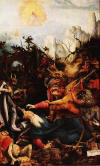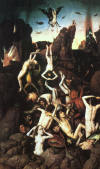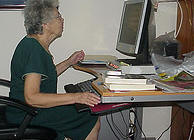|
Search:: Artists Alphabetically Symbolism 50 Greatest Paintings Art Movements 100 Greatest Painters The Effect of Plague on Art and Artists in the Middle Ages How the Plague Influenced Painters and Art in the Middle Ages Having no immunity and no understanding that the rats scurrying around their studios were carriers, the artists along with their neighbors dropped like flies. Back in the 14th century basic sanitation did not exist. Thousands of painters perished, including the great Sienese geniuses, Ambrogio Lorenzetti and Pietro Lorenzetti. The heart of the art world was torn open. The horrors of the black death pervaded all aspects of Medieval culture and especially art. Giovanni Boccaccio, Italian writer and poet who lived through the plague, wrote "They sickened by the thousands daily, and died unattended and without help. Many died in the open street, others dying in their houses, made it known by the stench of their rotting bodies. Consecrated churchyards did not suffice for the burial of the vast multitude of bodies, which were heaped by the hundreds in vast trenches, like goods in a ships hold and covered with a little earth." The effects were lasting, bringing a somber darkness to visual art, literature, and music. The dreadful trauma of this era instigated the imaginations of writers and painters in frightful and gruesome ways for decades to follow. The insecurity of daily survival created an atmosphere of gloom and doom, influencing artist to move away from joyful spiritual themes and turn to images of the apocalypse, hell, satan and the grim reaper. When the plague struck, Europe was emerging from the "dark ages" trying to put unpleasant memories behind it and move on to a more enlightened era. Barbarians no longer ran rough shod, putting entire villages to the torch and slaughtering the local peasants. Without the constant fear of invasion, art and architecture found fertile ground to grow. Medieval painters were not simply anonymous lowly craftsmen, but well respected professionals. They were held in high esteem and often interacted with clergy and wealthy patrons. The arrival of Black death harkened in a new darker era of painting. Artists were tormented by the constant menace of death, causing them to look for answers in scripture and the Church. Paintings overflow with tortured souls, death, dying, fire and brimstone.Symptoms include swelling of the lymph nodes, high fevers, large blackish pustules that soon burst and ooze a foul liquid, aching limbs, and vomiting of blood. Finally the victim became an unrecognizable, grotesque monster. The died by the millions, alone in agony, their kinsmen fleeing in terror. Government and Clergy tried to control the catastrophe, but the disease progressed relentlessly, eventually killing off a substantial segment of Europe's population. Preventing the Plague Many believed that the disease was spread upon the air, So, the survivors turned to incense, fragrant oils and perfumes to ward off the deadly vapors that they believed to be causing the infection. With so many bodies piling up, if nothing else the air smelled a bit better. Towns rang church bells and held parades where all the citizens paraded through the streets banging pots and pans to drive the plague away. Gypsies, Jews, foreign travelers, and lepers were rounded up and put into wooden building and roasted alive as they were believed to be the carriers of the disease. Medieval entrepreneurs made a fortune selling talismans, lucky charms and enchantments. Peasants who could not afford such luxuries simply wore a necklace of garlic around their necks or crushed herbs in their pockets. People were frantic for a remedy and would try anything, no matter how peculiar or bizarre. |
|
|
Life in the Middle Ages
In the Medieval period, people concentrated mainly on the church, God,
and personal salvation. Life in Medieval Europe was primitive and far
more difficult than that of Imperial Rome. The Average life
expectancy was only 30. Christianity provided an ethical
element lacking in previous cultures.
A song about the Plague from the Middle Ages
"A sickly season," the merchant said,
"I came away," the merchant said,
Major Painters from the Middle Ages
Coppo di Marcovaldo
Ambrogio Lorenzetti
If you feel you have worthwhile information you would like to contribute we would love to hear from you. We collect essential biographical information and artist quotes from folks all over the globe and appreciate your participation. When submitting please, if possible, site the source and provide English translation. Email to millardmulch@gmail.com copyright 2011 - historyofpainters.com
Require more information about The Consequences of Black Death on Art and Artists in the Middle Ages? Search Here If you have comment or would like to share an insight regarding The Effect of Black Death on Art and Artists in the Middle Ages, please submit your comment to the editor, via e-mail and if possible site the source. Thank you!
|



